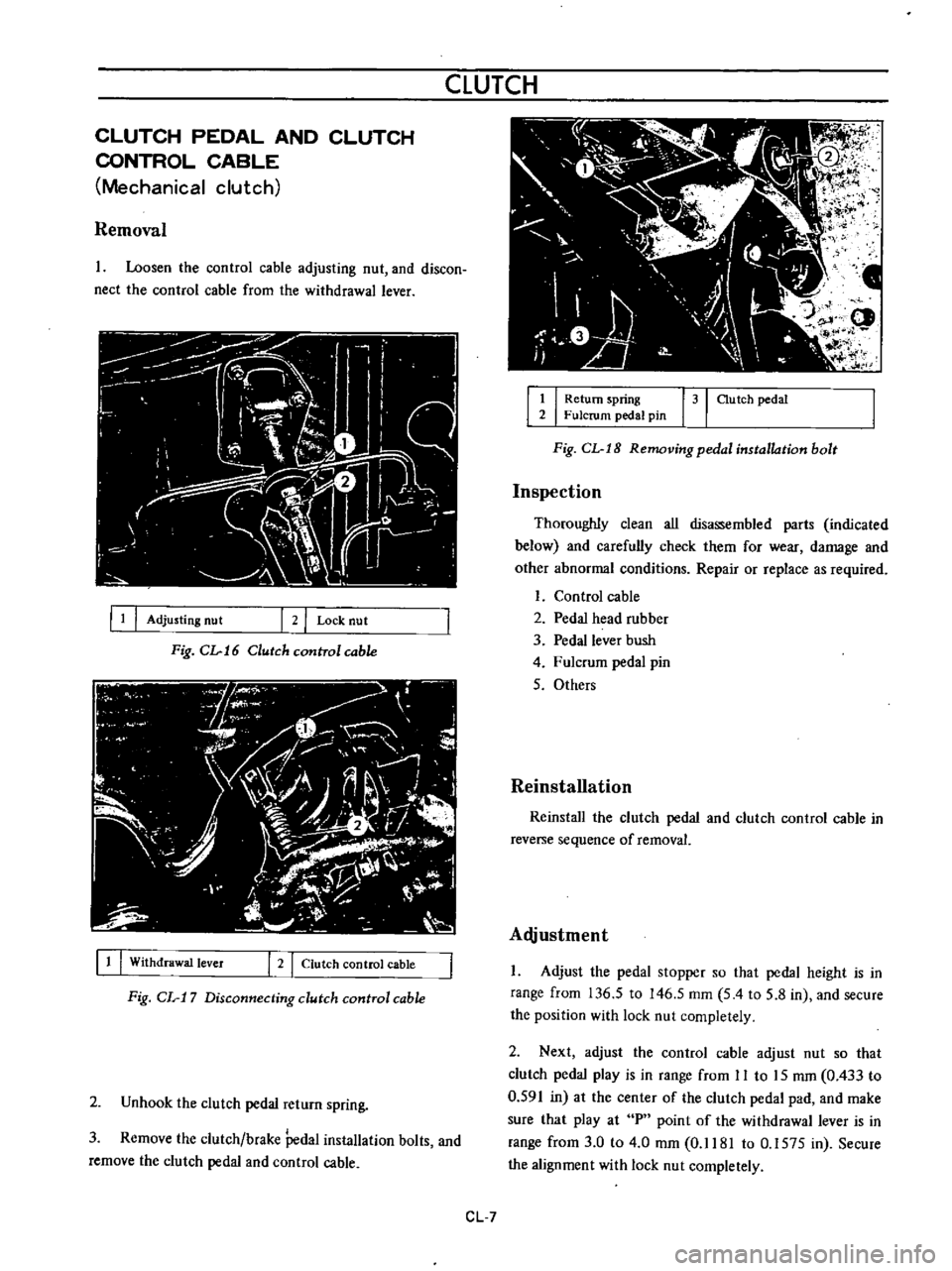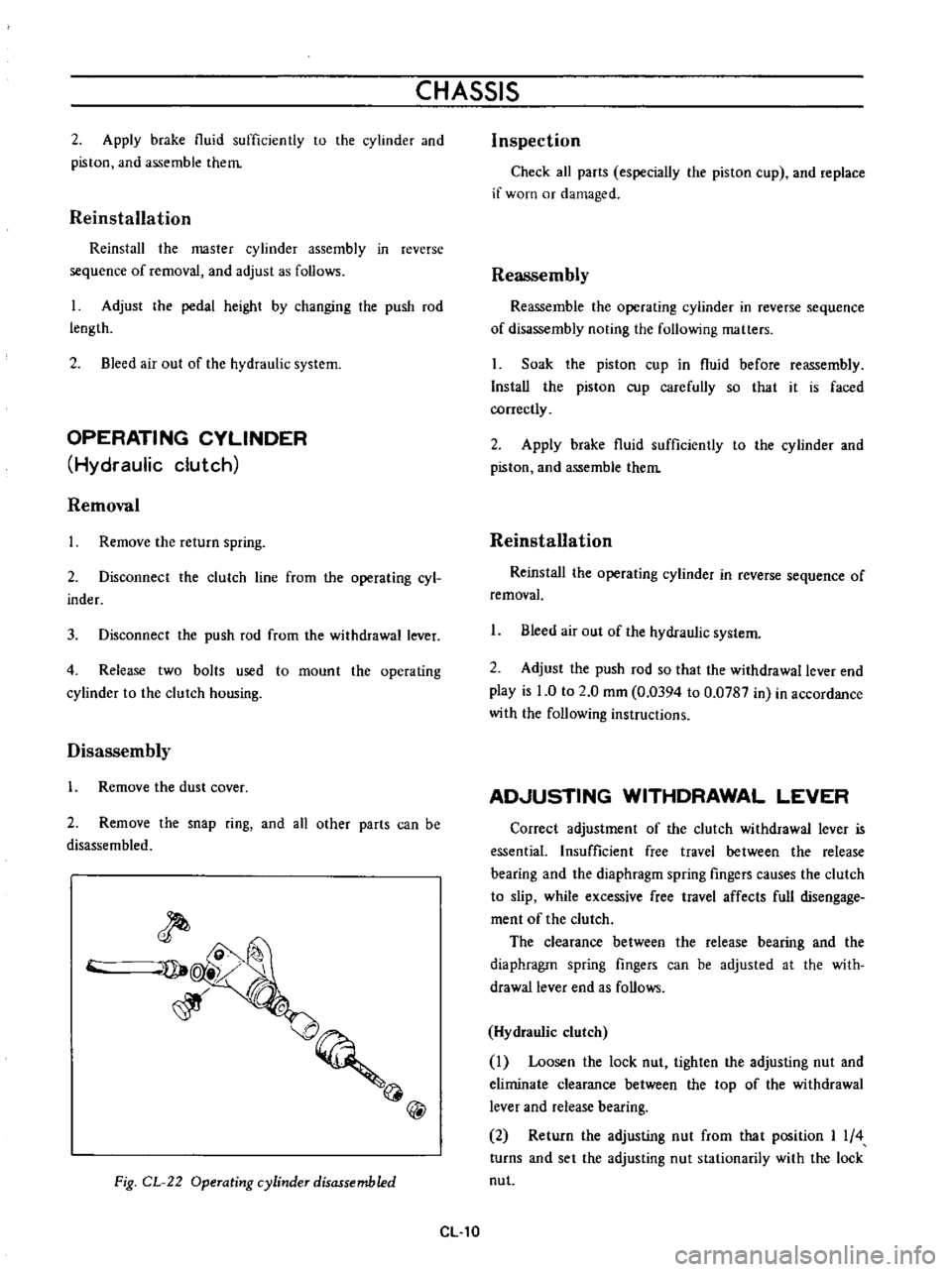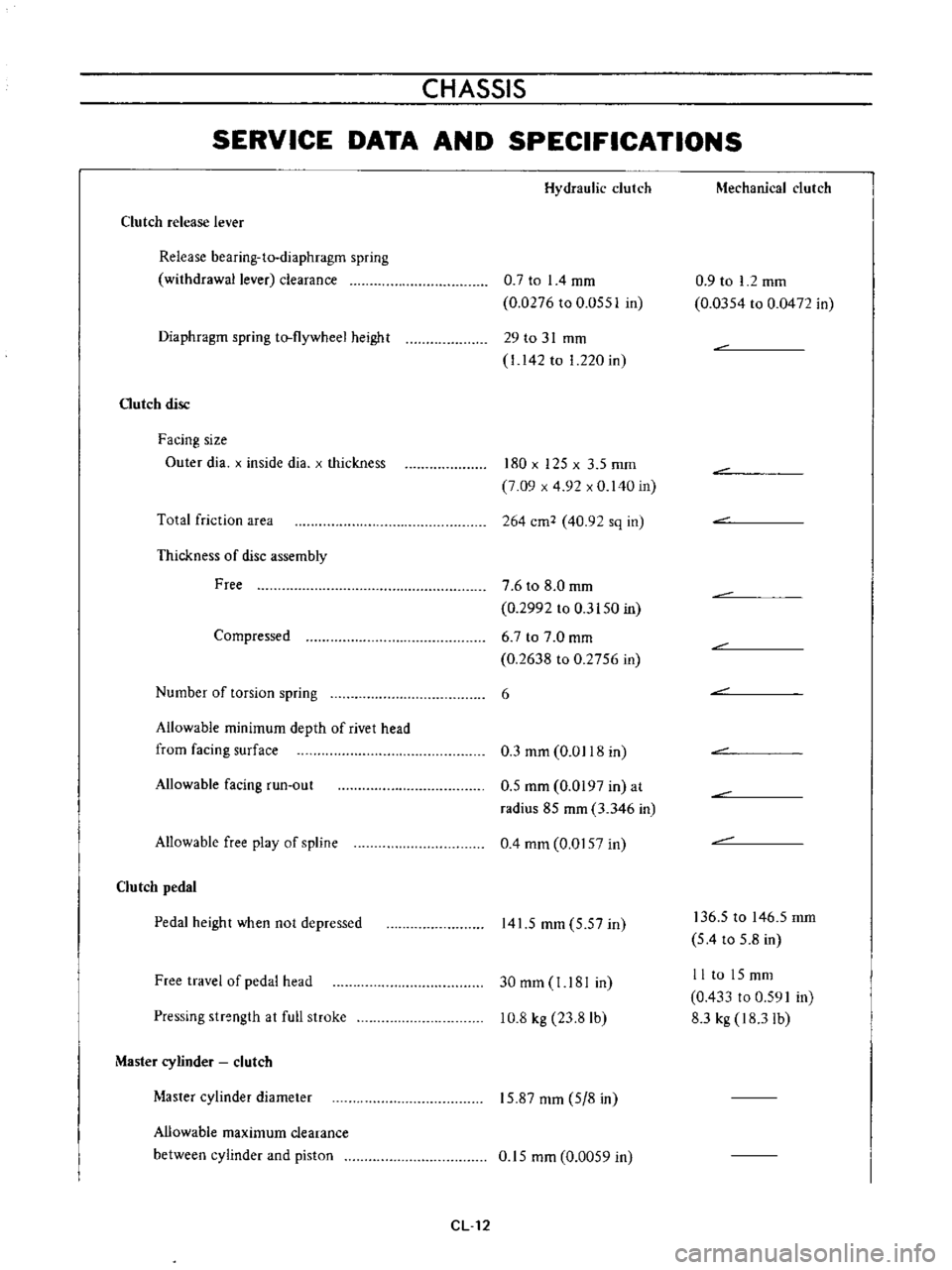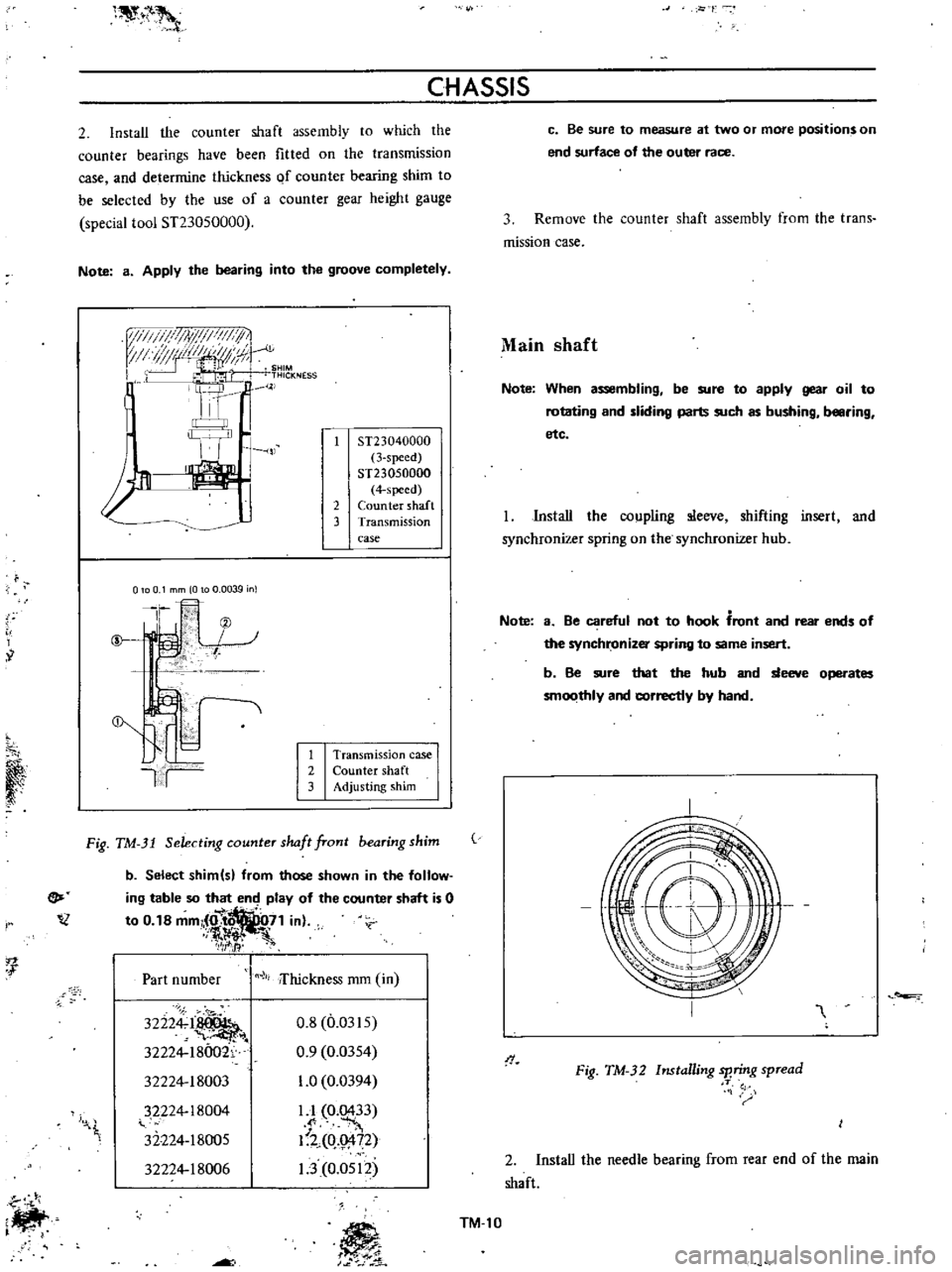Page 477 of 513

CLUTCH
CLUTCH
PEDAL
AND
CLUTCH
CONTROL
CABLE
Mechanical
clutch
Removal
Loosen
the
control
cable
adjusting
nut
and
discon
nect
the
control
cable
from
the
withdrawal
lever
III
Adjusting
nut
2
I
Lock
nut
Fig
CL
16
Clutch
cunITol
cable
11
I
Withdrawal
lever
I
2
I
Clutch
control
cable
Fig
CL
17
Disconnecting
clutch
control
cable
2
Unhook
the
clutch
pedal
return
spring
3
Remove
the
clutch
brake
Pedal
installation
bolts
and
remove
the
clutch
pedal
and
control
cable
1
I
Return
spring
31
au
tch
pedal
2
Fulcrum
pedal
pin
Fig
CL
I8
Removing
pedal
installation
bolt
Inspection
Thoroughly
clean
all
disassembled
parts
indicated
below
and
carefully
check
them
for
wear
damage
and
other
abnormal
conditions
Repair
or
replace
as
required
Control
cable
2
Pedal
head
rubber
3
Pedal
lever
bush
4
Fulcrum
pedal
pin
5
Others
Reinstallation
Reinstall
the
clutch
pedal
and
clutch
control
cable
in
reverse
sequence
of
removal
Alljustment
Adjust
the
pedal
stopper
so
that
pedal
height
is
in
range
from
136
5
to
146
5
mm
5
4
to
5
8
in
and
secure
the
position
with
lock
nut
completely
2
Next
adjust
the
control
cable
adjust
nut
so
that
clutch
pedal
play
is
in
range
from
II
to
15
mm
0
433
to
0
591
in
at
the
center
of
the
clutch
pedal
pad
and
make
sure
that
play
at
P
point
of
the
withdrawal
lever
is
in
range
from
3
0
to
4
0
mm
0
1181
to
0
1575
in
Secure
the
alignment
with
lock
nut
completely
CL
7
Page 478 of 513
CHASSIS
i
I
I
I
II
I
I
J
u
IlllrP
Zll
I
ff
Pedal
play
11
to
15
I
0
433
to
0
591
I
W
p
da
stfO
l
e
1
P
point
end
play
l
e
A
1
C
3
0
to
A
O
Chassis
grease
20
0
1181
to
0
1575
I
Y
136
5
to
lA6
5
I
5
A
to
5
81
0
Note
Connect
the
control
cable
correctly
so
that
mark
cap
is
faced
upward
as
shown
in
the
following
figure
Make
sure
that
chassis
grease
has
been
I
2
3
Lock
nu
t
Adjusting
nut
Pedal
stopper
applied
to
the
CG
marked
positions
three
places
Apply
grease
if
required
@
300R
t2
8J
Unit
mm
in
Fig
CL
19
Pedal
height
adjustment
3
When
the
clutch
pedal
is
heavy
remove
grease
filler
cap
from
front
portion
of
the
adjust
nut
and
grease
Be
sure
to
use
grease
containing
molybdenum
disulfide
Fig
CL
20
Greasing
to
the
nipple
of
clutch
control
cable
CL
8
Page 480 of 513

CHASSIS
2
Apply
brake
fluid
sufficiently
to
the
cylinder
and
piston
and
assemble
them
Reinstallation
Reinstall
the
master
cylinder
assembly
in
reverse
sequence
of
removal
and
adjust
as
follows
I
Adjust
the
pedal
height
by
changing
the
push
rod
length
2
B
eed
air
out
of
the
hydraulic
system
OPERATING
CYLINDER
Hydraulic
clutch
Removal
Remove
the
return
spring
2
Disconnect
the
clutch
line
from
the
operating
cyl
inder
3
Disconnect
the
push
rod
from
the
withdrawal
lever
4
Release
two
bolts
used
to
mount
the
operating
cylinder
to
the
clutch
housing
Disassembly
1
Remove
the
dust
cover
2
Remove
the
snap
ring
and
all
other
parts
can
be
disassembled
@
Fig
CL
22
Operating
cylinder
disassembled
CL
10
Inspection
Check
all
parts
especially
the
piston
cup
and
replace
if
worn
or
damaged
Reassembly
Reassemble
the
operating
cylinder
in
reverse
sequence
of
disassembly
noting
the
following
matters
Soak
the
piston
cup
in
fluid
before
reassembly
Install
the
piston
cup
carefully
so
that
it
is
faced
correctly
2
Apply
brake
fluid
sufficiently
to
the
cylinder
and
piston
and
assemble
them
Reinstallation
Reinstal
the
operating
cylinder
in
reverse
sequence
of
removal
1
Bleed
air
out
of
the
hydraulic
system
2
Adjust
the
push
rod
so
that
the
withdrawal
lever
end
play
is
0
to
2
0
mm
0
0394
to
0
0787
in
in
accordance
with
the
following
instructions
AD
USTING
WITHDRAWAL
LEVER
Correct
adjustment
of
the
clutch
withdrawal
lever
is
essential
Insufficient
free
travel
between
the
release
bearing
and
the
diaphragm
spring
fingers
causes
the
clutch
to
slip
while
excessive
free
travel
affects
full
disengage
ment
of
the
clutch
The
clearance
between
the
release
bearing
and
the
diaphragm
spring
fingers
can
be
adjusted
at
the
with
drawallever
end
as
follows
Hydraulic
clutch
Loosen
the
lock
nut
tighten
the
adjusting
nut
and
eliminate
clearance
between
the
top
of
the
withdrawal
lever
and
release
bearing
2
Return
the
adjusting
nut
from
that
position
I
4
turns
and
set
the
adjusting
nut
stationarily
with
the
lock
nut
Page 482 of 513

CHASSIS
SERVICE
DATA
AND
SPECIFICATIONS
Clutch
release
lever
Release
bearing
ta
diaphragm
spring
withdrawal
lever
clearance
Diaphragm
spring
to
flywheel
height
Gutch
disc
Facing
size
Outer
dia
x
inside
dia
x
thickness
Total
friction
area
Thickness
of
disc
assembly
Free
Compressed
Number
of
torsion
spring
Allowable
minimum
depth
of
rivet
head
from
facing
surface
Allowable
facing
run
out
Allowable
free
play
of
spline
Clutch
pedal
Pedal
height
when
not
depressed
Free
travel
of
pedal
head
Pressing
strength
at
full
stroke
Master
cylinder
clutch
Master
cylinder
diameter
Allowable
maximum
clearance
between
cylinder
and
piston
Hydraulic
clutch
0
7
to
I
4
mm
0
0276
to
0
055
in
29
to
31
mm
I
142
to
1
220
in
180
x
125
x
3
5
mm
7
09
x
4
92
x
0
140
in
264
cm2
40
92
sq
in
7
6
to
8
0
mm
0
2992
to
0
3150
in
6
7
to
7
0
mm
0
2638
to
0
2756
in
6
0
3
mm
0
0118
in
0
5
mm
0
0197
in
at
radius
85
mm
3
346
in
0
4
mm
0
0157
in
141
5
mm
5
57
in
30
mm
J
181
in
10
8
kg
23
8
Ib
15
87
mm
5
8
in
0
15
mm
0
0059
in
CL12
Mechanical
clutch
0
9
to
I
2
mm
0
0354
to
0
0472
in
136
5
to
146
5
mm
5
4
to
5
8
in
II
to
15mm
0
433
to
0
591
in
8
3
kg
18
31b
Page 497 of 513

1
i
I
iF
r
i
I
7
2
r
CHASSIS
2
Install
the
counter
shaft
assembly
to
which
the
counter
bearings
have
been
fitted
on
the
transmission
case
and
determine
thickness
Qf
counter
bearing
shim
to
be
selected
by
the
use
of
a
counter
gear
height
gauge
special
tool
ST23050000
Note
a
Apply
the
bearing
into
the
groove
completely
ij
I
i
I
lyi
FIII
I
1
1
TI
t
J
I
IJt
k
u
lN
III
1
0
SHIM
PC
I
1
7
L
THICKNESS
t
ll
l
1n
J
J
2
ST23040000
3
speed
ST23050000
4
specd
Counter
shaft
Transmission
case
o
0
1
mm
0
0
0039
n
Ir
@
f
@
II
1
Transmission
case
2
Counter
shaft
3
Adjusting
shim
Fig
TM
31
Selecting
counter
slullt
front
bearing
shim
e
lZ
b
Select
shim
s
from
those
shown
in
the
follow
ing
table
so
that
end
play
of
the
counter
shaft
is
0
to
0
18
mm
O
7
1
in
f1l
ft
7
fI
1
Part
number
lli
ifhickness
mm
in
32224
1
32224
18002
32224
18003
32224
18004
32224
18005
32224
18006
0
8
0
0315
0
9
0
0354
1
0
0
0394
LI
0
0433
I
Uo
g
72
1
3
0
0512
I
t
c
Be
sure
to
measure
at
two
or
more
positions
on
end
surface
of
the
outer
race
3
Remove
the
counter
shaft
assembly
from
the
trans
mission
case
Main
shaft
Note
When
assembling
be
sure
to
apply
gear
oil
to
rotating
and
sliding
parts
such
as
bushing
b
ring
etc
Install
the
coupling
sleeve
shifting
insert
and
synchronizer
spring
on
the
synchronizer
hub
Note
a
Be
careful
not
to
hook
front
and
rear
ends
of
the
synchronizer
spring
to
same
insert
b
Be
sure
that
the
hub
and
sleeve
operates
smoothly
and
correctly
by
hand
I
I
Fig
TM
32
Installing
sp
ring
spread
T
2
Install
the
needle
bearing
from
rear
end
of
the
main
shaft
TM
l0